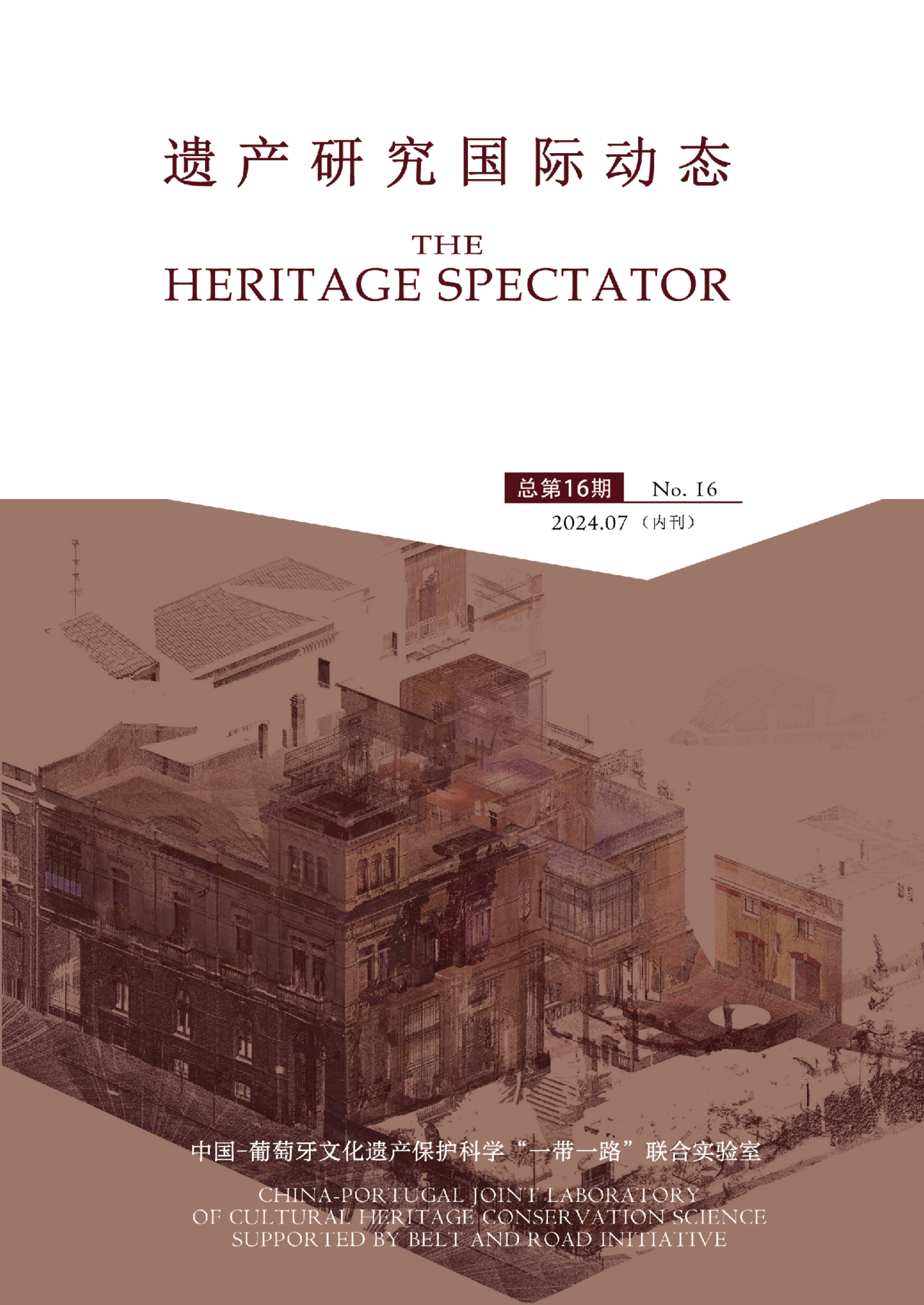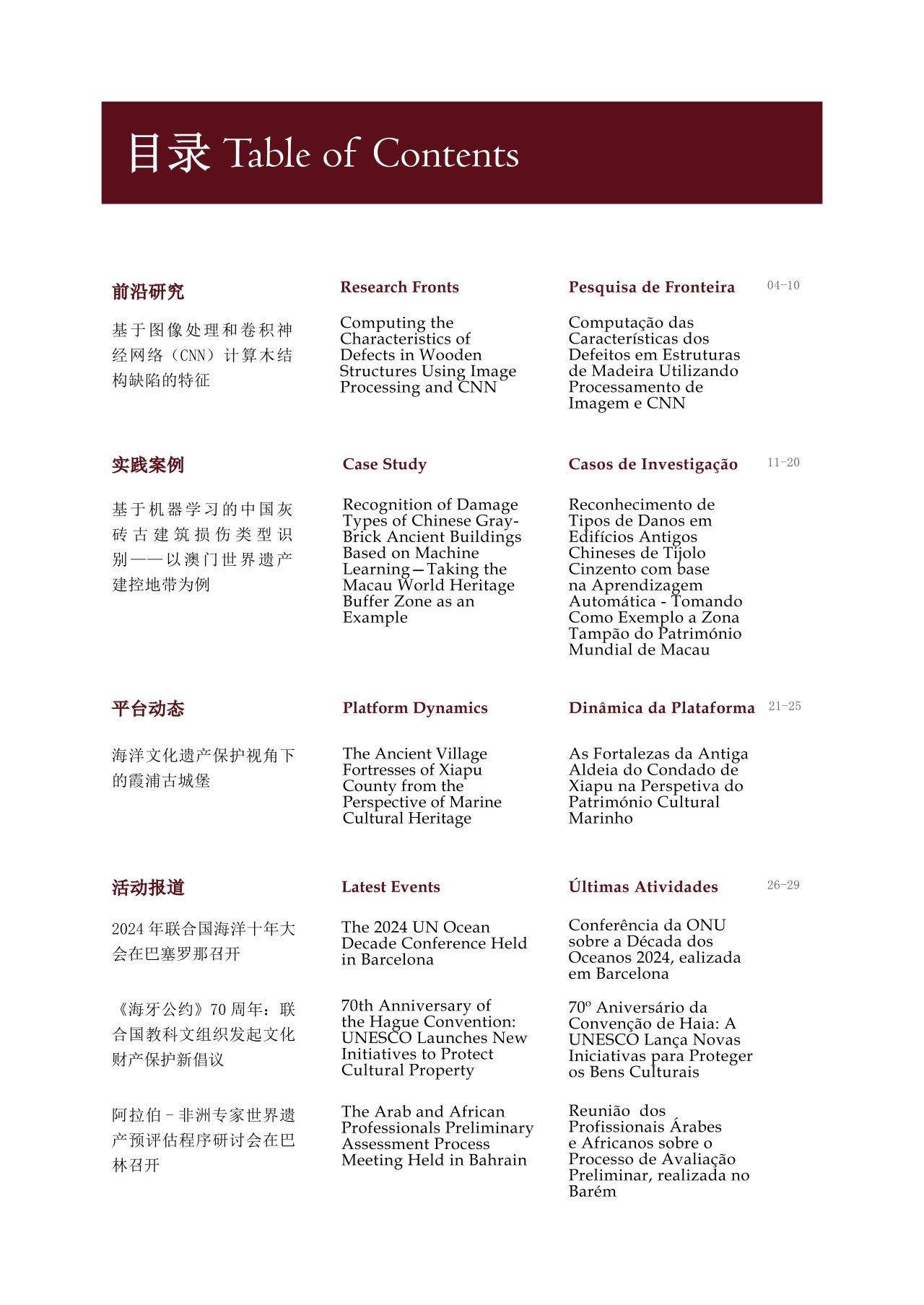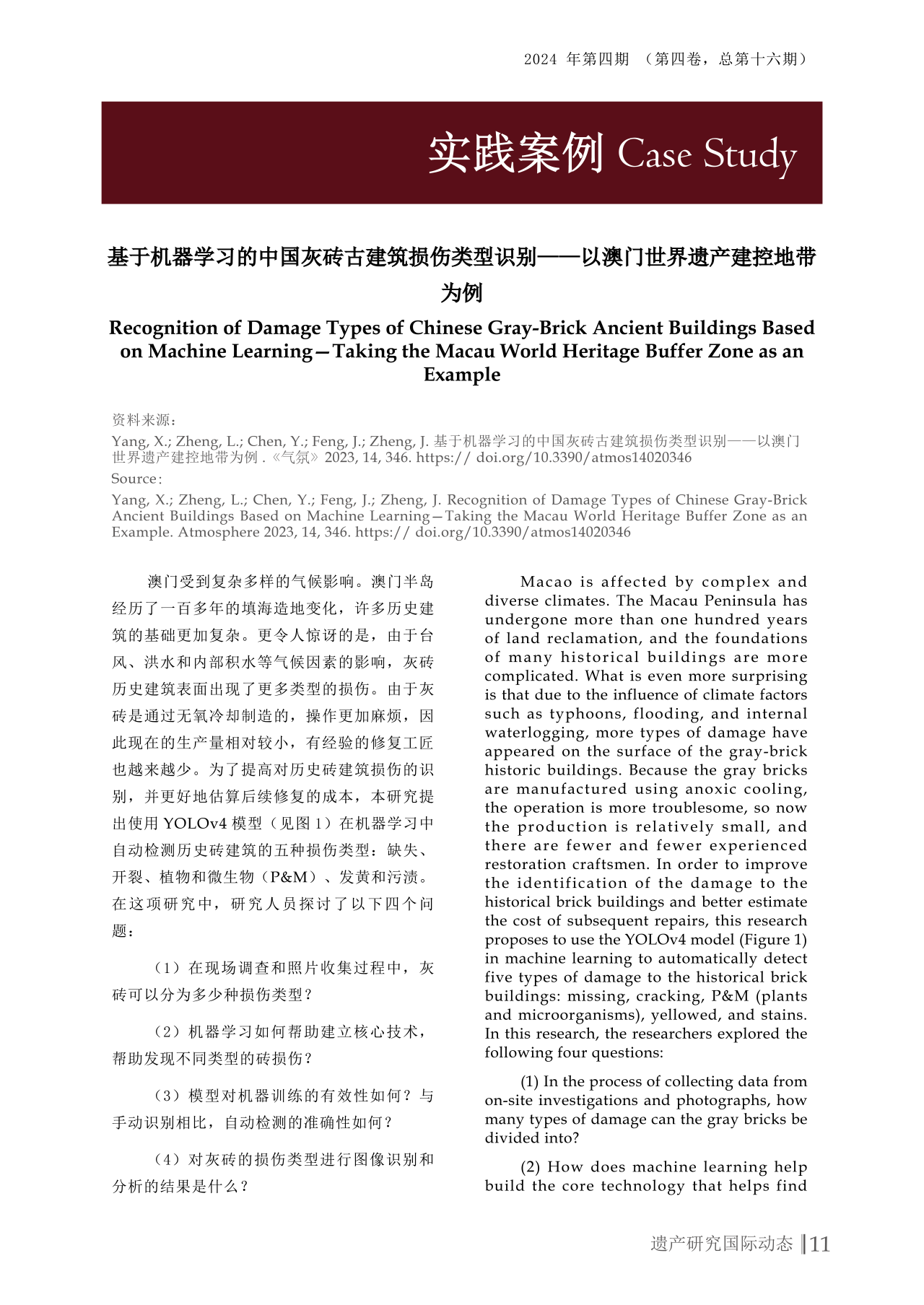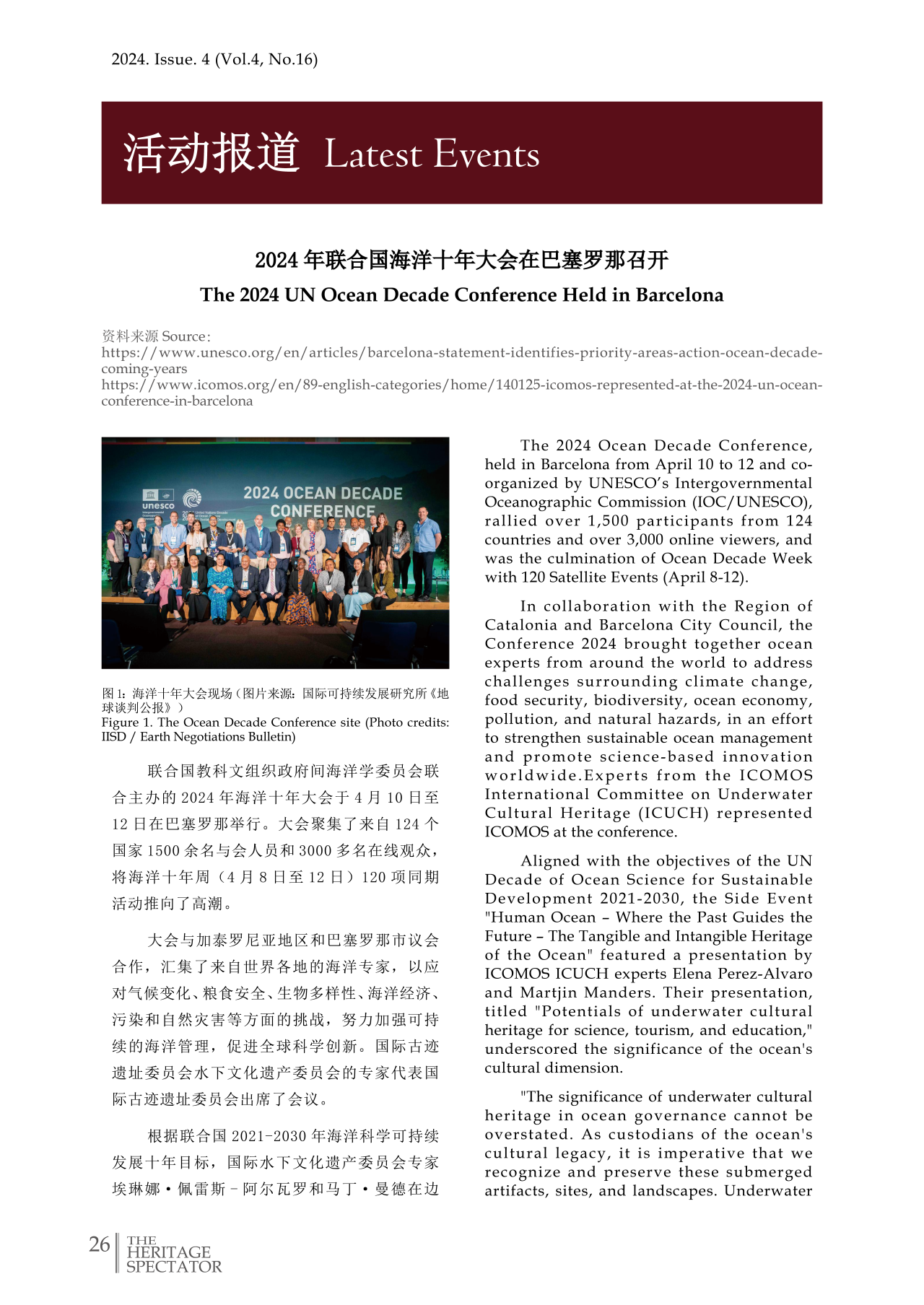联合实验室中英双语双月刊《遗产研究国际动态》(内刊)2024年第四期(总第十六期)已发布,全刊内容可在此下载
![]() JLBRI国家“一带一路“联合实验室《遗产研究国际动态》总第十六期The Heritage Spectator No.16.pdf
JLBRI国家“一带一路“联合实验室《遗产研究国际动态》总第十六期The Heritage Spectator No.16.pdf
前沿研究
基于图像处理和卷积神经网络(CNN)计算木结构缺陷的特征
本研究调查了木结构缺陷的分类和特征描述,特别是针对结疤和裂缝等异常现象。为此,利用卷积神经网络(CNN)的预测能力结合图像处理技术。值得注意的是,先前的研究已经探索了使用CNN和各种分割方法进行缺陷分类和识别。然而,本研究通过扩展分析以涵盖其他缺陷特征,引入了一个新的维度。除了传统的分类任务外,本研究还旨在计算和量化木结构缺陷的具体属性。这些属性包括但不限于与这些异常相关的角度、长度、宽度和缺陷面积。为了促进缺陷分类,采用了Inception-ResNet-V2预训练模型,并随后进行了严格的训练和验证。在此过程中,计算这些补充特征需要利用图像处理技术。应用严格的验证程序以确保计算的缺陷特征的稳健性和可靠性。
卷积神经网络(CNN)是一种深度人工神经网络,通常用于图像和视频的识别和分类任务。CNN模拟了人类视觉系统的分层处理机制,提取基本特征如边缘和形状,并将其组合以识别更复杂的特征如物体和场景。在结构系统中使用CNN进行检测、分类和测量目标元素具有诸多优点,如降低成本、加快过程和提高安全性。近年来,非接触式传感设备的进步增加了深度学习基础的状态评估方法在结构健康监测(SHM)社区中的采用。CNN通过大量数据集进行广泛训练,以识别各种类型的损伤和异常,并用于灾后侦查。
典型的CNN架构包括多层卷积滤波器,这些滤波器是应用于输入图像补丁的小权重矩阵。网络通过在整个图像上卷积滤波器来学习边缘、角点和纹理等特征。一个卷积层的输出然后输入到下一个层,使网络能够在每个阶段学习更复杂的特征。在分类问题中,网络的最终输出由每个可能类别的概率组成。CNN的一个显著优势是其能够从原始输入数据中自动学习相关特征,消除了手动特征工程的需求。这使得CNN在图像分类、物体检测和分割等任务中非常有效。此外,由于卷积滤波器应用于输入的小补丁,CNN可以处理各种大小和形状的输入数据。这种适应性使得CNN可以用于不同类型的输入数据,包括图像、视频和自然语言文本。
Computing the characteristics of defects in wooden structures using image processing and CNN
This research investigation delves into the classification and characterization of defects within wooden structures, specifically targeting anomalies such as knots and cracks. The predictive capabilities of Convolutional Neural Networks (CNNs) in conjunction with image processing techniques are harnessed for this purpose. It is noteworthy that prior research endeavors have explored defect classification and identification using CNNs and various segmentation methodologies. However, the current study introduces a novel dimension by extending the analysis to encompass additional defect characteristics. In addition to the conventional classification task, this research seeks to compute and quantify specific attributes of wooden structure defects. These attributes include but are not limited to the angle, length, width, and defective area associated with these anomalies. To facilitate the classification of defects, the Inception-ResNet-V2 pre-trained model is deployed and subsequently subjected to rigorous training and validation protocols. In parallel, the computation of these supplementary characteristics necessitates the utilization of image processing techniques. Stringent validation procedures are applied to ensure the robustness and reliability of the computed defect characteristics.
Artificial neural networks (ANNs) are a machine learning algorithm inspired by the structure and function of the human brain. They have been widely applied in various fields, including civil and structural engineering due to their ability to model and analyze complex systems. Applications include areas such as structural health monitoring, identification of structural damage, dynamic analysis of structures, structural modeling, risk assessment, planning and management of construction projects prediction of strength and other structural attributes, enhancement of energy efficiency, among others. ANNs have gained popularity because they can effectively solve intricate problems that traditional analytical methods struggle with. Convolutional Neural Networks (CNNs), a form of deep ANNs, are commonly used for tasks involving image and video recognition and classification. CNNs mimic the hierarchical processing of the human visual system, extracting basic features like edges and shapes and combining them to recognize more complex features like objects and scenes. The use of CNNs in structural systems for the detection, classification, and measurement of elements of interest has numerous advantages, such as cost reduction, process acceleration, and safety enhancement. Recent advancements in non-contact sensing devices have increased the adoption of deep learning-based condition assessment methodologies in the SHM community. CNNs are extensively trained using large datasets to identify various types of damage and anomalies, as well as for post-disaster reconnaissance.
A typical CNN architecture includes multiple layers of convolutional filters, which are small matrices of weights applied to patches of the input image. The network learns features like edges, corners, and textures by convolving the filters across the entire image. The output of one convolutional layer is then fed into the next layer, allowing the network to learn more complex features at each stage. In classification problems, the final output of the network consists of probabilities for each possible class or category. One significant advantage of CNNs is their ability to automatically learn relevant features from raw input data, eliminating the need for manual feature engineering. This makes CNNs highly effective for tasks like image classification, object detection, and segmentation. Additionally, CNNs can handle input data of varying sizes and shapes, thanks to the use of convolutional filters applied to small patches of the input. This adaptability allows CNNs to be used with different types of input data, including images, videos, and natural language text.
资料来源:
Rana E., Waqas Q., Charles V. Camp, etc. Computing the characteristics of defects in wooden structures using image processing and CNN[J]. Automation in Construction, Vol. 158, 2024.
实践案例
基于机器学习的中国灰砖古建筑损伤类型识别——以澳门世界遗产建控地带为例
澳门受到复杂多样的气候影响。澳门半岛经历了一百多年的填海造地变化,许多历史建筑的基础更加复杂。更令人惊讶的是,由于台风、洪水和内部积水等气候因素的影响,灰砖历史建筑表面出现了更多类型的损伤。由于灰砖是通过无氧冷却制造的,操作更加麻烦,因此现在的生产量相对较小,有经验的修复工匠也越来越少。为了提高对历史砖建筑损伤的识别,并更好地估算后续修复的成本,本研究提出使用YOLOv4模型在机器学习中自动检测历史砖建筑的五种损伤类型:缺失、开裂、植物和微生物(P&M)、发黄和污渍。在这项研究中,研究人员探讨了以下四个问题:
(1)在现场调查和照片收集过程中,灰砖可以分为多少种损伤类型?
(2)机器学习如何帮助建立核心技术,帮助发现不同类型的砖损伤?
(3)模型对机器训练的有效性如何?与手动识别相比,自动检测的准确性如何?
(4)对灰砖的损伤类型进行图像识别和分析的结果是什么?
Recognition of Damage Types of Chinese Gray-Brick Ancient Buildings Based on Machine Learning—Taking the Macau World Heritage Buffer Zone as an Example
Macao is affected by complex and diverse climates. The Macau peninsula has undergone more than one hundred years of reclamation and land reclamation changes, and the foundations of many historical buildings are more complicated. What is even more surprising is that due to the influence of climate factors such as typhoons, flooding, and internal waterlogging, more types of damage have appeared on the surface of the gray-brick historic buildings. Because the gray bricks are manufactured using anoxic cooling, the operation is more troublesome, so now the production is relatively small, and there are fewer and fewer experienced restoration craftsmen. In order to improve the identification of the damage to the historical brick buildings and better estimate the cost of subsequent repairs, this research proposes to use the YOLOv4 model(Fig.1) in machine learning to automatically detect five types of damage to the historical brick buildings: missing, cracking, P&M (plants and microorganisms), yellowed, and stains. In this research, the researchers explored the following four questions:
(1) In the process of collecting data from on-site investigations and photographs, how many types of damage can the gray bricks be divided into?
(2) How does machine learning help build the core technology that helps find different kinds of damage to bricks?
(3) How effective is the model for training machines? How accurate is automatic detection compared to manual identification?
(4) What is the result of the image recognition and analysis of the damage type of the gray brick?
资料来源:
Yang, X.; Zheng, L.; Chen, Y.; Feng, J.; Zheng, J. Recognition of Damage Types of Chinese Gray-Brick Ancient Buildings Based on Machine Learning—Taking the Macau World Heritage Buffer Zone as an Example. Atmosphere 2023, 14, 346. https:// doi.org/10.3390/atmos14020346.
平台动态
海洋文化遗产保护视角下的霞浦古城堡
闽东地区自古以来就是闽浙门户,中国东南海疆的咽喉要地。霞浦县元代在此置福宁州,明初虽一度降为福宁县,但成化九年(1473年)复升为州,清代改福宁州为福宁府,以今霞浦县为府治所在,辖霞浦、福安、寿宁、福鼎、宁德五个县。
明洪武二十年,为抵御倭患,朱元璋派江夏侯周德兴经略福建海防,构建了一个“五卫十二所”的沿海防御体系。其中大京所隶属福宁卫,是北面扼守闽海的第一道防线,周德兴营建的大京所城也成为霞浦县乃至闽东地区最早的城堡。作为官府建造的军事要塞,城堡最初并未在民间产生什么影响。明嘉靖三十六年(1557年)起,福建沿海的倭患陡然加剧,福宁州首当其冲。由于倭寇行踪不定,本地驻军兵力有限,用于守备府县城池已自顾不暇,以致乡间村落屡遭劫掠而爱莫能助。直至嘉靖三十八年(1559年)位于今柘荣县境内的柘洋城堡成功地抵御了倭寇进犯后,“乡人始知有城堡之利,而沿海五十七堡以次创筑云”。其中仅霞浦县就达四十二处,居福宁州诸县之首。至今霞浦县仍是保存明代城堡数量最多的区域,其中形制较完整的尚有二十余处。
The Ancient Village Fortresses of Xiapu County from the Perspective of Marine Cultural Heritage
East Fujian area has been the gateway to Fujian Province and Zhejiang Province since ancient times, which is the main throat of the southeast China sea border.In the Yuan Dynasty, Xiapu County was the capital of Funing State. In the early Ming Dynasty, it once down to Funing County, in the 9th year of the Chenghua emperor (1473) however, it was upgraded to state again. In Qing Dynasty Funing state had been Changed to Funing Fu, and governed five counties: Xiapu、Fuan、Shounen、Fuding and Ningde.
In the 20th year of Hongwu emperor(1388), in order to resist the Japanese pirates invasion, ZhuYuanzhang sent Zhou Dexing,the Marquis of Jiangxia, to patrol the coastal defense of Fujian,and constructed a coastal defense system, which named five guards and twelve posts. Funing guard was the first line of defense to guard the Fujian Sea in the north, and the Dajing fortress built by Zhou Dexing became the earliest fortress in the eastern part of Fujian. As a military fortress built by the government, the fortress initially did not have much impact on the civilians. In the 36th year of the Jiajing emperor (1557), the Japanese pirates invasion along the coast of Fujian increased dramatically, and Funing Fu was the first to bear the brunt of the invasion. Due to the uncertainty of the pirates and the limited strength of the local garrison, it was too much for them to take care of their own defense of the guard cities, villages in the countryside were repeatedly plundered and there was nothing they could do to help the civilians. Not until the 38th year of Jiajing emperor(1559), after the first village fortress bulit in Zheyang successfully resisted a invasion, people began to understand the benefits of the village fortress. According to the documents, there were at least 57 village fortresses built in Funing Fu during that time, and forty-two village fortresses of them located in Xiapu County. Up to the present, Xiapu County still keeps the largest number of ancient village fortresses, of which there are still more than 20 in a more complete form.
资料来源:
中国-葡萄牙文化遗产保护科学“一带一路”联合实验室福州研究基地
活动报道
2024年联合国海洋十年大会在巴塞罗那召开
联合国教科文组织政府间海洋学委员会联合主办的2024年海洋十年大会于4月10日至12日在巴塞罗那举行。大会聚集了来自124个国家1500余名与会人员和3000多名在线观众,将海洋十年周(4月8日至12日)120项同期活动推向了高潮。
大会与加泰罗尼亚地区和巴塞罗那市议会合作,汇集了来自世界各地的海洋专家,以应对气候变化、粮食安全、生物多样性、海洋经济、污染和自然灾害等方面的挑战,努力加强可持续的海洋管理,促进全球科学创新。国际古迹遗址委员会水下文化遗产委员会的专家代表国际古迹遗址委员会出席了会议。
The 2024 UN Ocean Decade Conference Held in Barcelona
The 2024 Ocean Decade Conference, held in Barcelona from April 10 to 12 and co-organized by UNESCO’s Intergovernmental Oceanographic Commission (IOC/UNESCO), rallied over 1,500 participants from 124 countries and over 3,000 online viewers, and was the culmination of Ocean Decade Week with 120 Satellite Events (April 8-12).
In collaboration with the Region of Catalonia and Barcelona City Council, the Conference 2024 brought together ocean experts from around the world to address challenges surrounding climate change, food security, biodiversity, ocean economy, pollution, and natural hazards, in an effort to strengthen sustainable ocean management and promote science-based innovation worldwide.Experts from the ICOMOS International Committee on Underwater Cultural Heritage (ICUCH) represented ICOMOS at the conference.
《海牙公约》70周年:联合国教科文组织发起文化财产保护新倡议
2024年5月13日至15日,由联合国教科文组织牵头、荷兰王国主办的“文化遗产与和平:基于《海牙公约》70年的建设”国际会议在公约签署的历史地点海牙如期举行。
1954年5月14日,在第二次世界大战破坏的余波中,国际社会在联合国教科文组织的主持下聚集在一起,通过了《关于发生武装冲突时保护文化财产的公约》,即《海牙公约》。它首次建立了一个明确且共同的全球法律框架,确保文化财产不受战斗行动的影响,并对蓄意破坏文化财产的行为追究法律责任。
70th Anniversary of the Hague Convention: UNESCO Launches New Initiatives to Protect Cultural Property
The international conference “Cultural Heritage and Peace: Building on 70 years of the Hague Convention”, was organized by UNESCO and hosted by the Kingdom of the Netherlands in The Hague on 13-15 May 2024, at the historical location and date of its signature.
On the 14th of May 1954, in the aftermath of the destruction wrought by the Second World War, the international community came together under the auspices of UNESCO to adopt the Convention for the Protection of Cultural Property in the Event of Armed Conflict, known as the Hague Convention. It established, for the very first time, a clear and shared global legal framework to ensure that cultural property would be protected from combat operations, and that those responsible for deliberate destruction of such property would be brought to justice.
阿拉伯-非洲专家世界遗产预评估程序研讨会在巴林召开
阿拉伯地区世界遗产中心与国际古迹遗址理事会、非洲世界遗产基金会、联合国教科文组织世界遗产中心和国际自然保护联盟合作,组织“阿拉伯-非洲专家世界遗产预评估程序研讨会”。会议于2024年5月15日至16日在巴林王国麦纳麦举行,来自阿拉伯地区和非洲国家的遗产专家出席了会议。
世界遗产委员会于2021年批准了一套《世界遗产名录》提名程序的新原则,包括(从预评估阶段开始的)两个阶段,以提高《世界遗产名录》提名的申报质量,促进《世界遗产公约》成员国及其咨询机构之间的合作。
The Arab Regional Centre for World Heritage Organized the Arab and African Professionals Preliminary Assessment Process Meeting
The Arab Regional Centre for World Heritage, in cooperation with the International Council on Monuments and Sites (ICOMOS), the African World Heritage Fund (AWHF), the UNESCO World Heritage Centre, and the International Union for Conservation of Nature (IUCN), organised the “Arab and African Professionals Preliminary Assessment Process Meeting”. The meeting took place from 15 to 16 May 2024 in Manama, Kingdom of Bahrain and was attended by a number of heritage experts from Arab and African countries.
In 2021, the World Heritage Committee approved a new set of principles for the Nomination process for the World Heritage List, including two stages (starting with the Preliminary Assessment stage), in order to improve the quality of Nominations submitted for the inscription on the World Heritage List and enhance cooperation between Member States of the World Heritage Convention and its Advisory Bodies.
资料来源:
https://www.icomos.org/en/89-english-categories/home/140125-icomos-represented-at-the-2024-un-ocean-conference-in-barcelona
https://www.unesco.org/en/articles/70th-anniversary-hague-convention-unesco-launches-new-initiatives-protect-cultural-property
https://www.arcwh.org/the-arab-regional-centre-for-world-heritage-organizes-the-arab-and-african-professionals-preliminary-assessment-process-meeting







